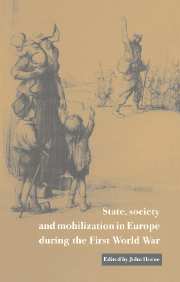Book contents
- Frontmatter
- Contents
- List of contributors
- Preface
- 1 Introduction: mobilizing for ‘total war’, 1914–1918
- I National ideals
- II Solidarities and minorities
- III Army and nation
- 8 Discipline and morale in the British army, 1917–1918
- 9 Remobilizing the citizen-soldier through the French army mutinies of 1917
- 10 The German army, the authoritarian nation-state and total war
- 11 Morale and patriotism in the Austro-Hungarian army, 1914–1918
- IV The limits and consequences of mobilization
- Notes
- Index
9 - Remobilizing the citizen-soldier through the French army mutinies of 1917
Published online by Cambridge University Press: 04 December 2009
- Frontmatter
- Contents
- List of contributors
- Preface
- 1 Introduction: mobilizing for ‘total war’, 1914–1918
- I National ideals
- II Solidarities and minorities
- III Army and nation
- 8 Discipline and morale in the British army, 1917–1918
- 9 Remobilizing the citizen-soldier through the French army mutinies of 1917
- 10 The German army, the authoritarian nation-state and total war
- 11 Morale and patriotism in the Austro-Hungarian army, 1914–1918
- IV The limits and consequences of mobilization
- Notes
- Index
Summary
With incidents of open resistance to military authority occurring in units of nearly one-half of the divisions in the French army, the mutinies of May and June 1917 constituted the most significant internal challenge to the prosecution of World War I in any of the victorious powers. In the terminology of this volume, the mutinies constituted dramatic acts of defiance of state mobilization at its most explicit level – that of formal military authority. Most commonly, a mutiny in a given unit involved an explicit refusal at embarkation points to take up positions in the front lines. The discontented soldiers would then hold some form of demonstration in which they would air all manner of grievances. Sometimes they protested about particular situations and commanders. More often, however, soldiers expressed a highly embittered disengagement from ‘the war’ writ large. Yet no less striking than soldiers' anger and even their despair was their restraint. Nearly everywhere, officers (the most immediate instruments of state authority) were treated with respect, even when they were openly disobeyed. Most importantly, soldiers did not cross the line into violent resistance, which could well have turned the mutinies into another French Revolution. Without the actual use of force on the part of the command structure, soldiers ultimately accepted remobilization into the war, and into a complex symbolic economy both of repression and of reforms in the way the war was carried out.
- Type
- Chapter
- Information
- Publisher: Cambridge University PressPrint publication year: 1997
- 2
- Cited by



